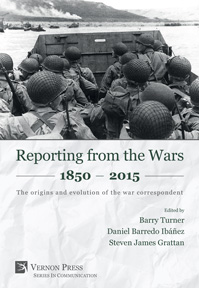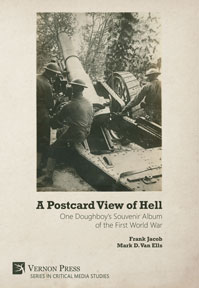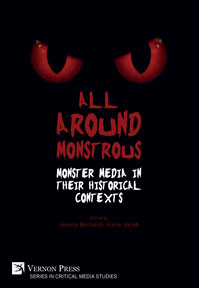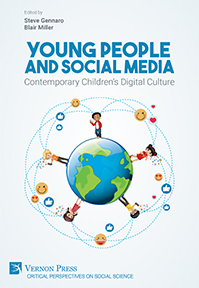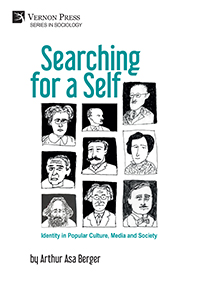Mediated Ideologies: Nordic Views on the History of the Press and Media Cultures
Jukka Kortti, Heidi Kurvinen (Eds.)
by Jukka Kortti (University of Helsinki, Finland), Heikki Kokko (Tampere University, Finland), Markku Mattila (Migration Institute, Finland), Ari Haasio (Seinäjoki University of Applied Sciences, Finland), Karin Jonsson (Södertörn University, Sweden), Tiina Kinnunen (University of Oulu, Finland), Arja Turunen (University of Jyväskylä, FInland), Hannah Yoken (University of Jyväskylä, Finland), Birgitte Kjos Fonn (Oslo Metropolitan University, Norway), Heidi Kurvinen (University of Turku, Finland)
Purchase this book
(click here to change currency)
This book shows that research on ideologies is back in media studies. Internationally informed, it directs its attention to the role of media in shaping and spreading ideological thinking in Nordic countries. It is my hope that it can inspire scholars to do more high-quality research–in regions all over the world.
Prof. Dr. Henrik G. Bastiansen
Art and Media Studies
Volda University College, Norway
Ideologies have not been a focus of interest in the field of humanities and social sciences in recent decades, but rethinking the power of ideologies in the media sphere has recently returned to the scholarly discussion. The compilation book “Mediated Ideologies: Nordic Views on the History of the Press and Media Cultures” participates in this by providing selected yet justified approaches to media history from the point of view of ideological uses of media in the Nordic region.
In this book, the role of media – comprising both popular media and news journalism – as a forum for ideologies and their circulation will be analyzed by focusing on the Nordic region. The perceived similarities in the media systems of the Nordic countries constitute a perfect extent for a regional media history against not only a European but also a global backdrop. This does not mean that there have not been many national differences.
The book does not provide a chronological narrative of Nordic media history. Still, the ideology of media is approached not only from the standpoints of different media forms – film, television, newspapers, magazines, and periodicals – but also from several historical periods from the mid-19th century to the late 20th century. The chapters show the multidimensional role that the media has in transmitting ideologies to their audiences and the public sphere. They also demonstrate that analyzing the role of different ideologies, such as modernization, nationalism, solidarity, feminism, and peace movement in media history provides wider perspectives in understanding past and present media landscapes and people’s mediated experiences that are fostered by them.
“Mediated Ideologies: Nordic Views on the History of the Press and Media Cultures” can be used both as a reference book and as a classroom adaption in the field of media, communication, and history studies.
List of tables
List of figures
Introduction: Ideologies in Nordic media history
Jukka Kortti
University of Helsinki, Finland
Heidi Kurvinen
University of Turku, Finland
Ideological conflict and consensus
Chapter 1 Village gossip or voice of the people? The culture of letters to the press in the grasp of transnational ideologies in mid-1800s Finland
Heikki Kokko
Tampere University, Finland
Chapter 2 Hate speech of the radical right in Finnish media during the 1930s and 2010s: The case of Ajan Suunta and Suomen Uutiset
Markku Mattila
Migration Institute of Finland
Ari Haasio
Seinäjoki University of Applied Sciences, Finland
Chapter 3 Solidarity in a new guise: The concept of solidarity in the Swedish social democratic party press 1980–1990
Karin Jonsson
Södertörn University, Sweden
Promoting and discussing feminism
Chapter 4 Hertha: A women’s rights magazine that did not see the light of day
Tiina Kinnunen
University of Oulu, Finland
Chapter 5 Parisian fashion or functional style? Ideal dress of the modern woman in Finnish women’s magazines in the 1920s and 1930s
Arja Turunen
University of Jyväskylä, Finland
Chapter 6 Producing and distributing feminist counterpublics: Magazines of the Nordic new women’s movements
Hannah Yoken
University of Jyväskylä, Finland
Transnational encounters and conflicts
Chapter 7 Post-war Americanization and Finnish cigarette television advertising
Jukka Kortti
University of Helsinki, Finland
Chapter 8 “We want to live. We want peace”: The peace movement in the Finnish and Swedish print media, 1980–1984
Heidi Kurvinen
University of Turku, Finland
Chapter 9 In our image: The revolution in Eastern Europe in two Norwegian newspapers
Birgitte Kjos Fonn
Oslo Metropolitan University, Norway
Bibliography
List of contributors
Index
Dr. Jukka Kortti is a social science historian, who has made several comprehensive studies on media history and intellectual history. As a media historian, he has published textbooks and theoretical articles and studied the history of television, advertising, journalism and documentary film. As a social historian, he has been interested in intellectual history, historical culture, university history, culture and student activism, the history of everyday life, the history of consumption and modernization processes. Currently, he directs two research projects at the University of Helsinki. He is the chair of Nordic Media History Network (NOMEH).
Heidi Kurvinen is a media historian who has specialized in the gendered history of professional journalism in the Nordic region as well as the encounters between social movements and mainstream media. Currently, she works as a Collegium Researcher at the Turku Institute for Advanced Studies (TIAS) in University of Turku, Finland. She is the secretary of Nordic Media History Network (NOMEH).
media history, ideology, Nordic region, journalism, journalistic modernity, media systems, Nordic images, Americanization, hate speech, social democracy, women’s’ movement, the Cold War
See also
Bibliographic Information
Book Title
Mediated Ideologies: Nordic Views on the History of the Press and Media Cultures
ISBN
978-1-64889-851-8
Edition
1st
Number of pages
252
Physical size
236mm x 160mm

![Mediated Ideologies: Nordic Views on the History of the Press and Media Cultures [Hardback]](/file/23560/00fcdfd76cf26b76498a107af6e0435c/1710942102.jpg)

